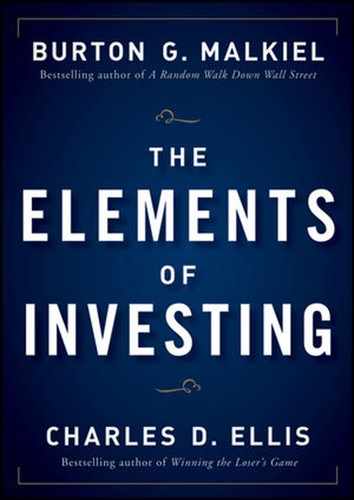In The Elements of Investing, Charley Ellis and Burt Malkiel, two of the investment world's greatest thinkers, combine their talents to produce a remarkable guide to personal finance. Having already written two of the finest books on financial markets, Ellis's Winning the Loser's Game and Malkiel's A Random Walk Down Wall Street, why should the authors revisit the subject of their already classic volumes? The sad fact is that in the cacophony of advice for individual investors, few sane voices are raised. In writing The Elements of Investing, the authors provide an important service to the lay reader, honing their message to the bare essentials by heeding Albert Einstein's dictum that "everything should be made as simple as possible, but not simpler."
Investors have three tools to deploy in the portfolio management process—asset allocation, market timing, and security selection. Asset allocation involves setting long-term targets for each of the asset classes in which an investor invests. Market timing consists of short-term bets against the long-term asset allocation targets. Security selection deals with the construction of the asset classes that an investor chooses to employ.
Ellis and Malkiel correctly focus on asset allocation since asset allocation accounts for more than 100 percent of investor returns. How can it be that more than 100 percent of returns come from the asset allocation decision? Market timing and security selection involve significant costs in the form of management fees paid to outside advisors and commissions extracted by Wall Street brokers. Such costs ensure that investors will underperform by the totality of investment management costs, which represent transfers from investors to their agents. Hence, the expensive activities of market timing and security selection reduce the returns available for the community of investors and that is the reason asset allocation explains more than 100 percent of investor returns.
Ellis and Malkiel observe that investors consistently make perverse market timing decisions, chasing hot performers and dumping laggards. Study after study of mutual fund trading concludes that investors buy high and sell low, subtracting value with their timing decisions. Ellis and Malkiel sensibly advise investors to adopt a coherent long-term strategy and stick with it.
Security selection decisions further reduce returns. Ellis and Malkiel cite depressing statistics regarding the failure of the majority of mutual fund managers to exceed the returns of low-cost, passive, market-matching index strategies. The documented dismal numbers only begin to capture the enormity of the situation. Ellis and Malkiel cite numbers only for funds that survived, a relatively successful subset of the mutual fund universe. The failures, which as a group produced miserable returns, are nowhere to be measured. Many funds disappeared. The Center for Research in Security Prices collects data on all mutual funds, dead or alive. As of December 2008, the Center tracked 39,000 funds, only 26,000 of which are active. The 13,000 failed funds do not show up in the authors' studies of past returns because the failed funds do not have current track records. (They disappeared, after all.) Considering the experience of mutual funds, dead and alive, reinforces Ellis and Malkiel's advice to take the low-cost, passive approach.
Of course, even in a slim volume, quibbles arise. I view home ownership more as a consumption good and less as an investment asset. I cast a skeptical eye on Ellis and Malkiel's implicit endorsement of stock picking in their confessions regarding personal success in security selection. (Is it surprising that two of the greatest figures in modern finance would figure out how to beat the market? Yes, they can pick stocks—the rest of us cannot.) I more emphatically recommend Vanguard, which, along with TIAA-CREF, operates on a not-for-profit basis and thereby eliminates the money management industry's pervasive conflict between profit motive and fiduciary responsibility. Quibbles aside, The Elements of Investing delivers an important and fundamentally valuable message.
When I was a doctoral student at Yale in the late 1970s my dissertation advisor, Nobel laureate James Tobin, suggested that I read A Random Walk Down Wall Street to learn about how markets really work. Burt Malkiel's wonderful book provided a critical foundation for my academic work. When I returned to Yale in the mid-1980s to manage Yale's endowment, I came across Investment Policy, the predecessor to Winning the Loser's Game. Charley Ellis's marvelous volume informed my approach to investment management in countless ways. Now, Charley Ellis and Burt Malkiel have produced a magnificent primer on investing for all of us. Follow their recommendations and prosper!
David F. Swensen
Author of Unconventional Success: A Fundamental Approach to Personal Investment
Chief Investment Officer, Yale University
July 2009
